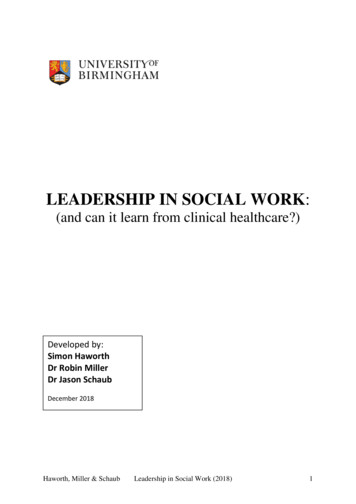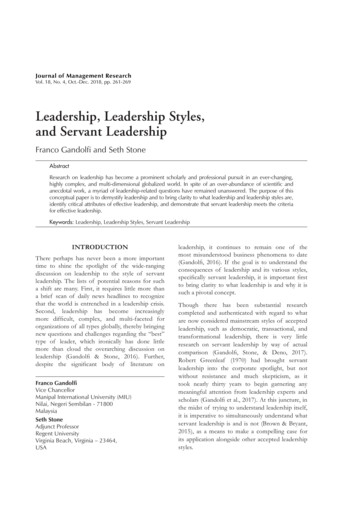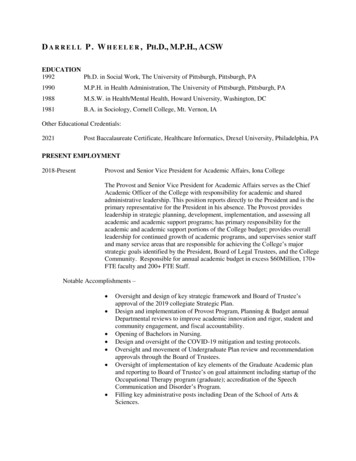
Transcription
LEADERSHIP IN SOCIAL WORK:(and can it learn from clinical healthcare?)Developed by:Simon HaworthDr Robin MillerDr Jason SchaubDecember 2018Haworth, Miller & SchaubLeadership in Social Work (2018)1
ForewordAs a profession, social work faces unprecedented pressures. Social care services, whichsocial workers help to deliver, have been subject to many years of central government cuts. Inaddition, demand for services is rising, placing huge and difficult to manage burdens onsocial workers. Local authorities struggle to recruit and retain enough social workers, and theprofession continues to suffer from negative public perceptions.In this context, it is vital that we have confident and effective social work leaders - those whocan inspire and lead teams and organisations in complex, multi-agency social care systems.This paper’s authors acknowledge these challenges facing social work, but contend that morecould be done to encourage and support better social work leadership. They argue thatcompared to other relevant professions, such as nursing and medicine, there is an insufficientinvestment in leadership at all stages in a social workers’ career; what they call the ‘cycle ofmissing leadership.’Yet good social work leadership is hugely important to the effectiveness and impact of socialcare services. In papers on strengths-based social work, Social Care Institute for Excellence(SCIE) discusses the importance of confident and skilled social work leadership toembedding strengths-based practice. In a tool for the What Works Centre for Children’sSocial Care, which SCIE is helping to establish, we identify excellent social work leadershipas a vital feature of evidence-minded organisations.This paper provides a helpful tour of a range useful frameworks for conceptualising socialwork leadership, identifies ways in which social work leadership can learn from clinicalleadership, and highlights gaps in the evidence and contributions to the professions’leadership development. The paper also presents a new and helpful definition of leadership insocial work.This paper makes an important contribution to the debate, but the authors are clear that it isjust a first step in what is hoped to become a productive dialogue between academics, socialworkers, regulators and government. Certainly, at a roundtable chaired by SCIE’s Chair PaulBurstow, used to inform the paper, the social work leaders in attendance were keen for thepaper to spark a much wider debate.The huge challenges facing social work, and social care more generally, are unlikely to abatein the near future. In this context, fostering excellent social work leadership will be moreimportant than ever, and this paper kicks starts what we hope is a fruitful debate that leads toreal change.Ewan King, Chief Operating Officer, SCIEHaworth, Miller & SchaubLeadership in Social Work (2018)2
IntroductionLeadership is recognised as an enabler of well-functioning organisations. Within socialwork, well-led services and professions will contribute to people, families andcommunities experiencing positive and enabling support that improves their lifeopportunities and wellbeing. Leadership is also highlighted in reviews of what has notworked well, either through focussing on the wrong objectives or being noticeable byits absence. Social work with adults, and with children and families, has professionalstatus, designated legislative responsibilities, central roles in safeguarding the mostvulnerable, and an institutional and democratically elected organisational home.Despite these foundations, social work in England often presents as a profession incrisis, unsure of its distinctiveness, strengths and contribution. This corresponds withsocial work being undervalued by other professions and overlooked by society ingeneral. It is therefore crucial that social work has a strong sense of its purpose withstrong leadership to develop and sustain the profession into the future.This working paper seeks to add to debates about social work leadership withinEngland. It begins by tracing out definitions, models and research evidence. It isnoteworthy that much (but not all) of the social work leadership literature used in thispaper originated from the United States of America, not the UK, raising questionsabout the significance given to leadership within the UK social work community andits researchers. The current context of social work in England is considered as thebackdrop against which leadership must be realised. The core elements of leadershipin social work are analogous to those in other professions (Sullivan 2016), and thusthere are grounds to the argument that social work should not see itself as unique interms of how leadership is conceptualised and enacted. This opens the door tolearning from other sectors. Healthcare has recognised the potential benefits ofleadership for many decades with active support from policy and practice. This paperconcludes by highlighting the main areas for debate and setting out ways in whichthese could be positively addressed.Haworth, Miller & SchaubLeadership in Social Work (2018)3
Leadership and Social workDefinitions of LeadershipLeadership in social work is poorly defined. This applies within England, the UK andfurther afield, both within children and families and adults fields, and with no coherentmodel or definition systematically employed or endorsed (Hafford-Letchfield et al,2014; Sullivan, 2016; Lawler & Bilson, 2013). As Lawler (2007) states, ‘we are still inthe position of having no generally accepted definition of leadership or what it mightbe within social work’ (p. 133). A further complication is that the knowledge base ismostly conceptual and lacks a robust empirical basis (Hafford-Letchfield et al, 2014).Meanwhile, the importance of effective leadership has been highlighted by a range ofscholars and reports, including the two most prominent reviews of child protectionpractice in England. Almost ten years ago Laming (2009) reminded us that seriouscase reviews consistently refer to the importance of effective leadership. In herseminal review of child protection, Munro (2011) stated that ‘Leadership will be neededthroughout organisations to implement the review’s recommendations successfully,especially to help move from a command-and-control culture encouraging complianceto a learning and adapting culture’ (p.107). These underscore the importance ascribedto leadership for improving social work practice.However, the context of contemporary social work can be understood as inhibiting thedevelopment of confident and effective leadership, through managerialism,bureaucratic dominance, or cultures of fear and blame (Hafford-Letchfield et al, 2014;Rogowski, 2012; Lawler & Bilson, 2013; Sullivan, 2016). Confident and effectiveleadership is complex, daunting and multi-faceted; as a result, managerialism can beseen as a defensive response to such complexity and uncertainty, steering social workorganisations towards expediency, efficiency and rigid structures (Lawler, 2007;Rogowski, 2011).There is limited attention to leadership in social work education and a potentialincongruence between education for frontline practice and education for leadership(Lawler & Bilson, 2013; Holosko, 2009; Perlmutter, 2006). The Social Work Task Forcefound that teaching on organisational leadership skills was largely absent fromcurriculums (Taylor, 2013). Social work education must, therefore, take someresponsibility for the lack of progress in fostering healthy and effective leadership insocial work (Holosko, 2009); as must the various governing bodies (which have beenHaworth, Miller & SchaubLeadership in Social Work (2018)4
in flux for the past decade). For instance, Colby Peters (2018) found that the Healthand Care Professions Council proficiencies fail to mention the word lead at all.These issues are exacerbated by pervasive recruitment and retention challenges,which contribute to staff shortages and, as a result, knowledge and expertise leavingthe profession (Hopkins et al, 2014; Smith, 2005). For example, children and families’social work is confronted with high turnover of staff and vacancy rates, withexperienced and committed practitioners amongst those leaving the profession(Baginsky, 2013; Collins, 2008). This cycle can encourage organisations to movepractitioners into formal leadership positions without the macro-level knowledge andexperience needed to fulfil the role (Bliss, Pecukonis & Snyder-Vogel, 2014). Inaddition, social workers can be placed in leadership positions and may not have thetraining or experience to be good leaders, holding the role because of years of service.This type of promotion suggests that they may not have developed the leadershipskills necessary for the role (Iachini, Cross & Freedman, 2015; Sullivan, 2018).These intersecting issues move social work away from leadership based on expertiseand in-depth knowledge of practice, as advocated in healthcare (Goodall 2016;Goodall and Pogrebna, 2015). In fact, given the consistency of public enquiries,challenging regulator reviews, serious case reviews and media scandals, effectivecrisis leadership can be viewed as more necessary for social work in the UK (Lawler& Bilson, 2013) than leadership based on expertise.Models of LeadershipThere are different leadership models promoted in children and families and adults’fields, and between more specific practice areas. The following section presentsseveral of these models, and considers them critically for their contribution to ourknowledge base. For instance, the literature review revealed a surprisingly highproportion of leadership papers from the palliative care field (e.g. Blacker et al, 2016;Cullen, 2013; Davidson, 2016; Jones et al, 2014). These texts explore collaborativeinter-disciplinary leadership, the benefits of specific leadership programmes and theimportance of interprofessional leadership education. It conceptualises leadership inbroad terms as an activity where practitioners influence the practice of others, not asa role or status limited to management or senior practitioners. It is perhaps noteworthyHaworth, Miller & SchaubLeadership in Social Work (2018)5
that this area of social work is multi-disciplinary and entwined with health professionalsand services.Some scholars (Iachini, Cross and Freedman, 2015) have suggested specific types ofleadership as more aligned to social work values. They considered how leadership isincorporated in social work education from a US perspective. They specifically cite thesocial change model of leadership as promoting the core values of social work.Furthermore, authors including Jones and Phillips (2016) and Blacker (2016) proposethat, because of this value base, the social work profession is in a strong position tolead interprofessional education within health care.Transformational leadership features heavily in the literature (Colby Peters, 2018;Hafford-Letchfield et al, 2014; Northouse, 2016). This model derives from businessand utilises ideas of change and innovation, personal charisma, intellectualstimulation, and valuing and listening to followers (Northouse, 2016). This model’spotential appeal to social work derives from leaders assisting transformation byvaluing individuals and being accessible, inspirational and enabling (Lawler & Bilson,2013; Martin, Charlesworth & Henderson, 2010). Furthermore, this type of leadershipis associated with transforming staff perceptions, emphasis on collective action andcommitment, and motivating practitioners to achieve both individual and organisationalgoals (Hafford-Letchfield et al, 2014; Sullivan, 2016).Participatory or distributed leadership features prominently in the literature. This modelis associated with developing shared purposes and values, collaborative cultures,continuous improvement and authentic shared leadership. In this model context isimportant, and leadership is understood as a practice distributed over leaders,followers, and their shared situation (Carpenter, 2015; Gibson, 2017; Spillane,Halverson & Diamond, 2004). Gibson (2017) describes that this model ‘brings thesituation to the fore, treating it as something more than a backdrop or container forleaders’ practices, instead treating it as integral to defining specific leadership activity’(p. 38). Distributed leadership aligns closely with the social work value base,incorporating professional ideals of empowerment and egalitarianism as emphasisedby the International Federation of Social Worker’s Global Definition of Social Work(2014). This model focuses on leadership practice, as opposed to roles, and thedevelopment of common democratic working cultures (Hafford-Letchfield et al, 2014).Haworth, Miller & SchaubLeadership in Social Work (2018)6
Client-centred leadership is identified as a preferred model by some scholars (e.g.Sullivan, 2016). This model is linked but different from distributed leadership, andcould present issues of paternalism for a UK context, because the lack ofconsideration of the power imbalance between professional and client. This model ispredicated on the client or service user as the preeminent focus, with the motivationand job satisfaction of practitioners merely acting as a means towards the desired endof meeting service users’ needs and improving their life circumstances. Within thismodel the gap between leaders and service users should be minimal, with regularinteractions between leaders and service users a key feature.Communities of practice has potential relevance for the development of leadership insocial work, given the concepts’ focus on structuring social learning and promotingleadership through knowledge and expertise. Wenger, McDermott and Snyder (2002)define a community of practice as ‘a group of people who share a concern or passionfor something they do and learn how to do it better as they interact regularly’ (p. 22).Communities of practice have three foundational elements. Firstly, identity is formedby a shared domain of interest; secondly, members build constructive relationshipsthat enable them to learn from each other; and thirdly, members develop a sharedcollection of resources, tools, and problem-solving techniques to evolve highstandards of shared practice (Wenger, 1998). The development of such communitiescould encourage a more communal, relational and knowledge-based approach toleadership, connecting with social work values of empowerment and collective action,while encouraging peer support and a common sense of leadership identity (Gray etal, 2010; Hafford-Letchfield et al, 2014; Wenger, McDermott & Snyder, 2002).Adaptive leadership holds some relevance for social work, given the variety and speedof change in the sector. Its consideration of supporting people to manage changecould be seen as a useful model to apply for social work contexts. Adaptive leadershipconceptualises leadership though interactions between leaders and followers,recognising the mutual effects, and therefore opens leadership to those who are notin formal leadership positions. This model focusses primarily on leadership behavioursthat are congruent with learning, innovation and adaptation. It recognises complexityin the workplace and advocates for leadership to support, rather than take control of,change and problem solving (Northouse, 2016; Heiftez et al, 2009).Haworth, Miller & SchaubLeadership in Social Work (2018)7
Systems leadership has gained increasing prominence in recent years through therecognition in England and internationally that new forms of collaboration betweenprofessions, organisations and sectors are vital to respond to changing demographyand poor outcomes due to continued fragmentations between services (Miller et al2016, SCIE 2018a). Ghate et et al (2013) define it as ‘leadership across organisationaland geopolitical boundaries, beyond individual professional disciplines, within a rangeof organisational and stakeholder cultures .to effect change for positive social benefitacross multiple interacting and intersecting systems’ (p13). It builds on previousthinking relating to the power of collaborations, the importance of diversity and the roleof social movements to influencing complex adaptive systems (Welbourn et al 2012).Developing it in practice requires working not only with the leaders but also the systemin which they operate to ensure that new innovative approaches can adopted(Fillingham & Weir 2014).There are some definitions of leadership (e.g., Holosko, 2009) that suggest it shouldinclude vision, a collaborative approach, problem-solving, the ability to influence theviews and actions of others, and the ability to inspire and cultivate change. Thedevelopment of leadership in social work could look to these ideas and peer externallyfor inspiration, knowledge and pertinent leadership models (towards healthcare inparticular). As Sullivan (2016) proposes ‘ the task of a leader in a human serviceorganisation is to create the context for professionals to perform in an efficaciousfashion and to be a steward of a culture in which the client always comes first’ (p. 559).As a result, perhaps leadership in social work can encourage improvement, innovationand the valuing of every individual in, or associated with, its enterprise, focussing onthe desired effects of leadership as opposed to leadership as a status or specific role.Developing LeadershipA recent review of practice frameworks for the West Midlands Social Work TeachingPartnership outlined practice development and leadership within the UK social workcontext (Gibson, 2017). It examined leadership development frameworks whereprofessional practice was central. The review concluded that leadership should bebased upon the pillars of distributed leadership, supportive practice environmentslinked to professional values and deliberate organisational and individual actionsHaworth, Miller & SchaubLeadership in Social Work (2018)8
aimed to improve practice. Furthermore, it suggested that leadership should be recastas a mindset and activity as opposed to a person or role, and that leadership shouldfocus on practice development and innovation separate from administration andmanagement (Gibson, 2017). Drawing on this review, Stanley and Kelly’s (2018) workdescribed the development of a practice leadership framework. They suggested thatUK social work leadership should use the foundations of practice frameworks,sociological imagination, research in practice and IFSW principles. The strength of themodel is drawn from its focus on the connection of leadership to social work practiceand values. It discusses the role of the Principal Social Worker, concluding that afterfive years it seems unlikely to realise the stated aim of practice leadership focussedupon leadership as a bridge between front-line practice and strategic decision-making.It is important to note that this view is open to challenge.There are examples of inventive practice, as evidenced by projects funded by theChildren’s Social Care Innovation Programme for example (McNeish et al, 2017). Oneprogramme being developed and delivered within children’s social work is the PracticeSupervisor Development Programme. It is funded by the Department for Educationand jointly delivered by Research in Practice and specific universities. Thisprogramme is looking to ‘educate’ 700 practice supervisors by 2020. The programmewill incorporate the KSS and support practice supervisors to develop knowledge, skillsand values in their roles. Another is the Practice Leader Development Programme.Facilitated bv practice leaders from a number of London based Local Authorities andthe Department for Education, a central element of the programme is a coachingrelationship with an experienced leader. The programme seeks to bridge the transitionfrom learning into practice by maintaining this relationship for the first twelve monthsof participants taking up such roles.Social Work Leadership – an ambiguous concept?When considering the range of models and knowledge from the above section, whatis striking is that there is no clear model of leadership that is promoted by theprofession. This lack of clarity may create complications for the profession to developits voice, to develop its knowledge base, and to respond to external threats. As a ‘juniorprofession’ in comparison to the more established medicine and law, these issues areHaworth, Miller & SchaubLeadership in Social Work (2018)9
of particular concern. In the UK, social work has made a clear differentiation betweenitself and ‘clinical’ settings, suggesting that an approach that is more person-centredis preferred (to note, in other countries this is not the case). Whilst this is laudable, thismay have removed social work from the supporting structures that healthcareprovides, with its greater funding and more positive public perceptions.What may be possible to be gleaned from the above, however, is that social work islikely to link closely with models of distributed leadership. This model presents clearalignment to social work values.Haworth, Miller & SchaubLeadership in Social Work (2018)10
Context of social work practiceWhen considering social work leadership in England, it is important to consider notonly the knowledge currently being developed, but the context in which the leadershipis enacted. Social workers are employed in a variety of organisations, and work witha wide range of service users. Many work in local authorities, undertaking children andadults social care roles, but they also work in voluntary and charitable organisations(also called ‘The Third Sector’). Because of the diversity, scanning across theworkforce to make coherent suggestions is challenging. In addition, what might besuitable for one sector may be irrelevant or unhelpful for another. Social work in theUK is often portrayed as experiencing a state of near-perpetual change and, in additionto this turmoil, significant funding cuts have impacted children and families and adults’services alike (Rogowski, 2011; Cummins, 2018). Furthermore, practice is oftendescribed as dominated by organisational objectives, audit cultures and bureaucracy(Green, 2009; Morris, Featherstone & White, 2014). This context and issues likelyhinder the development of confident leadership, and leading social work practice isoften fraught and challenging (Aronson and Smith 2010; Stanley & Kelly, 2018).Given these complexity, this section considers local authority social work in England.Given this boundary, there are a number of key elements to consider: contextualchange; the political and public context of social work; the impact of inspections,scandals and serious case reviews; recruitment and retention of social workers(including changes to working patterns); effects of significant recent budget cuts; andsocial work profession’s status and values.Professional ReformsSocial work in England has experienced a decade of sustained and significant changeincluding the formation of a Task Force and Reform Board (Social Work Task Force2009a; Social Work Reform Board 2010, 2012), two high profile reviews of childprotection (Laming 2009; Munro 2011), and two of social work education (CroisdaleAppleby 2014; Narey, 2014). The successive Labour, Coalition and minorityConservative governments have recommended a sweeping series of significantreforms, including the establishment and then abolition of the first ever College ofSocial Work (TCSW). These reforms have included: a new overarching professionalstandards framework in the Professional Capabilities Framework (PCF), previouslyHaworth, Miller & SchaubLeadership in Social Work (2018)11
held by TCSW, and later by the British Association of Social Workers (BASW, 2018);the appointment of two Chief Social Workers (one for Children and Families and onefor Adults) to give professional leadership and improve the influence of social work onpolicy; and the Assessed and Supported Year in Employment (ASYE). ASYE offersadditional support to social workers in their first year of practice and, along with thePCF, provides a benchmark against which all new social workers’ knowledge andcapability can be objectively assessed at the end of their first year (Social WorkReform Board 2012). The Chief Social Workers have issued Knowledge and SkillsStatements (KSS) for social workers working with children and families (Departmentfor Education, 2014) and adults (Department of Health, 2014). In addition, Social WorkEngland, the new professional regulator, has recently come into effect. There havebeen concerns raised about the speed and scale of these changes, suggesting thatthey do not allow changes to be embedded before further transformation.The respective KSS for children and families and adults social work hold potentialrelevance and opportunities for leadership within UK social work. Within the childrenand families field there is a specific KSS for practice leaders, which aims to providethe basis for accrediting practice leaders within the field. It covers areas such asleading excellent practice, designing systems to support excellent practice anddeveloping excellent practitioners (DfE, 2015). This KSS informs the practice leaderdevelopment programme, which aims to facilitate leadership through learning in-roleand experientially. There is no analogous KSS specifically for practice leaders inadults’ social work. However, the KSS for social workers in adults does refer toleadership, if only briefly, in requirement 10 entitled ‘professional ethics andleadership’ (Department of Health, 2014).There are some developments designed to encourage innovation in children’s socialcare which are helpful to consider here. These include the What Works Centre forChildren’s Social Care and the Children’s Social Care Innovation Programme. Thesetwo are interlinked, and examine the settings for social care, and how to improve theservice. Of particular interest for this paper is the What Works Centre’s definition of itsremit:‘We will generate evidence where it is found to be lacking, improve itsaccessibility and relevance to the practice community, and support practiceleaders (e.g. principal social workers, heads of service, assistant directors andHaworth, Miller & SchaubLeadership in Social Work (2018)12
directors) to create the conditions for more evidence-informed practice in theirorganisations.’ (www.whatworks-csc.org.uk/)The Innovation Programme also identifies the importance of practice leaders within itsround one evaluation (DfE, 2018). In this document, the ‘Seven Enablers ofImprovement’ can all be linked to leadership concepts discussed in this paper:1. Strategic approach - Rigorous and forensic self-assessment; open and honestto external feedback; develop a vision and strategic plan that is right for theorganisation.2. Leadership and governance - Maintain the right, stable, focussed leadershipat all levels; don’t rush into a restructure; establish effective, professionalgovernance.3. Engaging and supporting the workforce - Change the rhetoric and avoid the‘blame game’; articulate high expectations and ambitious goals; stabilise theworkforce; develop staff from within.4. Engaging partners - Engage senior partners; align thresholds; reviewpractices through multi-agency audits; remain outward facing.5. Building the supporting apparatus - Maintain a secure front door; ensure theflow of cases reflects a child’s journey; know the business; develop routines totrack progress.6. Fostering innovation – Create a learning culture; test and pilot new ideascarefully; evaluate rigorously.7. Judicious use of resources – Ensure strategic and financial planning arealigned; invest where it is needed; sustain investment until improvement isembedded; focus on long term priorities.This evaluation links these enablers to features of practice and outcomes, and itsuggests that this leadership is necessary to improve practice and outcomes. Theseoutcomes align to government targets.Haworth, Miller & SchaubLeadership in Social Work (2018)13
Diagram 1: Seven Features of Practice and Seven Outcomes (DfE, 2018)Political and Public Context of Social WorkWorking for local councils is a significant factor in the experience of social workers inmodern practice. It is important to note that local councils are government entities witha great deal of autonomy, and that local councillors are elected officials. As a result,the oversight of the council by elected members has a significant effect on the dailyworking life of social workers. Elected local councillors provide strategic leadershipand make decisions about budgets and priorities, with the senior managementresponsible for advising the councillors and implementing their decisions (LGA 2012).Changes in electoral response can have significant effects on the individuals in chargeof budget- and target-setting, some of which can be influenced by ideology. Therelationship between elected members and employed senior managers can bechallenging, with the strategy-setting sometimes at odds with the needs of the localpopulation.A more uncomfortable consideration is the difference in public perception between theNHS and social care. Media stories often equate the NHS as a ‘religion’ (Field, 2016),Haworth, Miller & SchaubLeadership in Social Work (2018)14
but the comparable perception is of an over-bearing and ‘failing’ social care sector.This has been considerably affected by a series of scandals, going back decades(Butler and Drakeford 2011), which have seen social work (which is closely aligned tochild protection) repeatedly battered by media storms. It is important to identify thatthe ‘public inquiry and the media coverage of it were as much, if not more, an inquiryinto social work as it was about child protection policy and practice and that socialwork was found wanting’ (Parton, 2011: 1216). These scandals, and the resultinginquiri
leadership is complex, daunting and multi-faceted; as a result, managerialism can be seen as a defensive response to such complexity and uncertainty, steering social work organisations towards expediency, efficiency and rigid structures (Lawler, 2007; Rogowski, 2011). There is limited attention to leadership in social work education and a .











